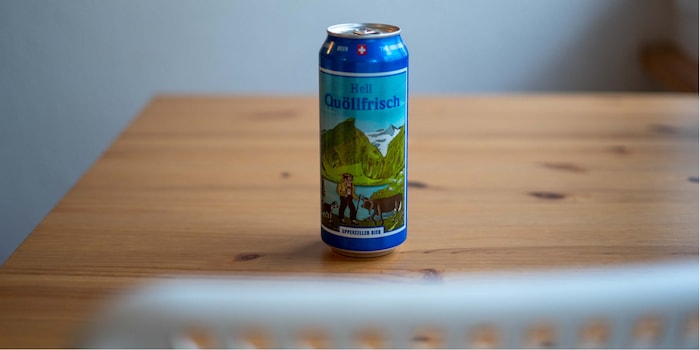

In honour of its birthday: three reasons to choose canned beer
You’d be hard-pressed to find an opinion more persistent than that «canned beer is of inferior quality and more harmful to the environment than bottled beer». Wrong – on all counts. To celebrate its birthday, here’s a song of praise for canned beer.
Eighty-seven years ago today in the USA, the first canned beer rolled off the assembly line. It became a global success. Rightly so, because canned beer has almost only advantages.
Who even buys bottled beer these days? I decided to ask my coworkers in our team chat: how do you prefer to drink your beer? From a can, from a bottle, or do both make you equally happy? Eight people said bottled beer, only my colleague Ramon said canned beer. Two people said it made no difference. This reflects public opinion; at first, canned beer was considered inferior. Fun-punk band NoRMAhl celebrated canned beer in their cover of Fraggle Rock. And in «Werner Beinhart», Eckhart has a canned beer holder bolted to his motorbike.
But back to my survey: my results almost match those of a study from 2016. The participants were poured the same beer – once from a bottle, and once from a can. Knowing this, over 60 per cent said the bottled was better. Only 11 per cent said the canned beer was better. The test was then repeated without the participants being allowed to see the beer containers. In this blind test, 45 per cent said the canned beer was better, and 45 per cent said the bottled beer was better. So, there's no real difference in terms of taste. But in terms of everything else, Ramon is the only one who’s right; there’s much to be said for canned beer and much to be said against bottled beer.
1. Canned beer is airtight and light-proof
In contrast to glass bottles, no air at all can seep into cans. As a result, the beer stays fresh longer. Crown caps inevitably let air in or CO₂ out after a certain time, which makes the beer stale or causes a change in taste. Sunlight is even worse. UV rays are the death of bottled beer; a complex chemical reaction produces a compound very similar to skunk spray. That’s why it’s often referred to as «skunked beer». Skunked beer has a foul odour and taste, but it isn’t toxic. Beer in green and transparent bottles is particularly susceptible to becoming skunked. Brown bottles, on the other hand, offer some UV protection.
2. Canned beer is more resistant to drops and easier to transport
If you’re headed for a barbecue by the river or a picnic in the woods, canned beer is your best bet. It takes up less space in your backpack, is less susceptible to falls, and is about 20 per cent lighter than glass bottles. The only thing that speaks in the favour of glass is its thermal properties. Glass heats up much less quickly than aluminium, so bottled beer stays cold longer in your backpack. At the same time, because aluminium conducts temperatures much more rapidly than glass, beer in aluminium cans cools down more quickly.
3. Canned beer is more environmentally friendly than disposable glass bottles
Aluminium requires a relatively large amount of energy to produce, but disposable glass bottles have the same problem when it comes to recycling, as melting them requires very high temperatures. Another argument against glass: transporting it takes more energy due to its higher weight. So, disposable glass bottles really are the worst solution for beer. If you don’t like drinking beer straight from the can, you can pour it into a drinking glass. I recommend doing so either way. The right glass will make any beer taste better. By the way, Swiss beer from deposit bottles is just as recommended – as long as you can store it away from light and in a cool place.
I often hear that canned beer has a metallic taste. This may be true if you drink the beer straight from the can. But I’m quite certain you’re just imagining it. At worst, canned beer may warm up more quickly and then lose some of its carbon dioxide. Locher brewery is aware of this and has recently started producing its beer in various can sizes, such as these 150 ml cans or the somewhat larger 33 cl cans below.

When I flew the family nest over 15 years ago, I suddenly had to cook for myself. But it wasn’t long until this necessity became a virtue. Today, rattling those pots and pans is a fundamental part of my life. I’m a true foodie and devour everything from junk food to star-awarded cuisine. Literally. I eat way too fast.
Practical solutions for everyday problems with technology, household hacks and much more.
Show all

